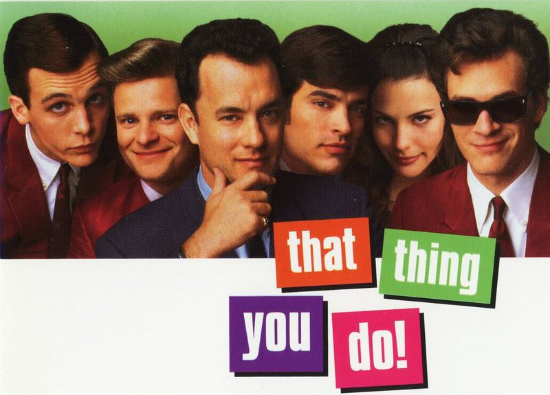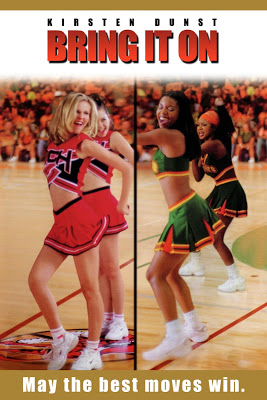
This guest post by Lisa Anderson appears as part of our theme week on Movie Soundtracks.
What makes a film’s soundtrack memorable? Some beloved films, such as Pulp Fiction, pull together varying songs to capture the essence of a film, while others, like O Brother Where Art Thou? have artists covering existing songs specifically for the movie in question. That Thing You Do! (1996) took a novel approach somewhere in the middle. Writer/director Tom Hanks collaborated with others to create original songs in the style of various musical genres of the time and record them under the name of fictional musical acts from the movie. Despite its initial popularity and the success of the movie, the resulting album has fallen into relative obscurity, but I believe it still holds up.
The movie itself tells the story of a fictional “One-Hit Wonder” band from 1960s Eerie, Pennsylvania. Young Guy Patterson, played by Tom Everett Scott, is asked to sit in with a band for a local contest after their usual drummer (Giovanni Ribisi in a bit role) breaks his arm. Guy brings a new tempo to the band’s signature song, “That Thing You Do!” and also gives them their new name: The Oneders, which is pronounced “Wonders” but hilariously mispronounced “Oh-nee-ders” on multiple occasions.

The pepped-up version of “That Thing You Do!” becomes a hit, and the Oneders go from local radio play to the state fair circuit to the Billboard charts and national TV. Along the way, they have help from Andrew White (Tom Hanks), their manager with the fictional Play-Tone records, and Faye (Liv Tyler), the lead singer’s mistreated girlfriend, after whom Guy pines. Success turns sour, as it inevitably must (at least in the movies), but not before the audience is treated to many great songs that sound like they’re lifted straight from the 60s.
[youtube_sc url=”https://www.youtube.com/watch?v=wPMLG8mnCRM”]
As the film opens, we hear “Lovin’ You Lots and Lots,” by the Norm Wooster Singers — a shout-out to the tame, almost muzak-like sound that’s about to be supplanted by rock ‘n’ roll. As the Oneders play gigs, we hear them perform not only “That Thing You Do!” (of course), but also “Little Wid One,” “Dance With Me Tonight,” and “All My Lonely Dreams.” The first two are up-tempo 1960s rock, while the latter is a slow ballad of the sort that the lead singer, Jimmy, apparently has a proclivity for. His post-Oneders band, the Heardsmen, also has two songs on the soundtrack: “She Knows It” and “I Need You (That Thing you Do),” although the latter is also attributed to the Oneders.
It’s when the Oneders go on a state fair tour with other Play-Tone artists that the music gets even more varied. “Hold my Hand, Hold my Heart” by the Chantrellines captures the sound of Black all-girl groups such as the Supremes. “Mr Downtown,” by Freddy Fredrickson, combines a lounge-lizard sound with the feel of a James Bond title song and a dash of Raymond Chandler. Diane Dane sings in the tradition of female soloist torch singers on “My World is Over.” The Vicksburgs, a rock band much like the Oneders, alludes to the era’s fascination with the automobile in “Drive Faster.”
The world of the Oneders is full of instrumental music, too. “Voyage Around the Moon,” by The Saturn 5, is a spot-on homage to surf music. Cap’n Geech and the Shrimp Shack Shooters provide the sound for the Beach-movie phenomenon in “Shrimp Shack,” and are portrayed by the Oneders in a metafictional movie. Not least of all, Del Paxton, Guy’s favorite jazz musician, performs “Time to Blow.” My only regret is that “I am Spartacus,” Del’s Jam session with Guy, didn’t make the cut.
The movie presents some interesting challenges to those interested in social justice analysis, and it’s hard to say whether that’s a weakness of the script or due to the restrictive cultural environment in which the story takes place. The only named Black characters are somewhat stereotyped — the sage Jazz musician Del and Lamar, the cheerful hotel concierge. But Guy expresses a deep respect for specific Black musicians on several occasions, and the movie seems very conscious of how much American music owes to Black musicians.
[youtube_sc url=”https://www.youtube.com/watch?v=JJZQzUuN7Eo”]
The movie does less, in my opinion, to redeem its depiction of women. Most of the female characters seem shallow and hyper-focused on their romantic relationships, with the exception of Faye, who is also very relationship-focused, but is given more substance and seems more genuinely interested in music. Unfortunately, this sets her up as an Exceptional Woman — the kind who you know is better than the rest because her friends are all men — and the movie only passes the Bechdel test by a brief early exchange between her and Guy’s girlfriend. She could have more agency in terms of her relationships, too, but the movie does a nice job of contrasting how Jimmy treats her with how Guy treats her. (On a more subversive note, “Little Wild One” is basically all about the sexual double-standard.)

In the end, Guy must reconnect with his his love of making music in order to decide what to do with his life after the Oneders. That Thing You Do! is not the least predictable movie ever, but with its sly humor, strong performances and ultimately heartwarming romance makes for satisfying viewing. It’s a meditation on the tension between art and commerce that manages to acknowledge what can be good about temporary fame. It’s also a squeaky-clean antidote to sordid, drug-filled “Behind-the Music”-type stories, both fictional and real.
The soundtrack to That Thing You Do! was released by Epic Records under the name of the label from the movie, Play-Tone Records. Hanks later spun off Play-Tone as his own label, to release other movie and television soundtracks, including Bring It On and the soundtrack to The Sopranos. Almost 20 years later, I remain impressed by the quality of the songs and how closely they imitated the genres of the era, and I heartily recommend both the movie and its music.









